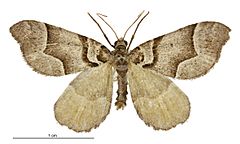Helastia siris facts for kids
Quick facts for kids Helastia siris |
|
|---|---|
 |
|
| Male | |
| Scientific classification | |
| Kingdom: | |
| Phylum: | |
| Subphylum: | |
| Class: | |
| Order: | |
| Family: | |
| Genus: |
Helastia
|
| Species: |
H. siris
|
| Binomial name | |
| Helastia siris (Hawthorne, 1897)
|
|
| Synonyms | |
|
|
Helastia siris is a type of moth that belongs to the Geometridae family. This special moth lives only in New Zealand. It is considered "At Risk, Relict" by the Department of Conservation, which means it needs help to survive.
Contents
How it Got its Name
This moth was first described in 1897 by E. F. Hawthorne. He found a specimen in Wellington and named it Asaphodes siris. Later, a scientist named George Hudson wrote about this moth in his books. In 1987, Robin C. Craw placed this moth into the Helastia group. The original specimen used to describe the moth is kept at the Museum of New Zealand Te Papa Tongarewa.
What it Looks Like
This moth has wings that spread about 2.2 centimeters (about 7/8 of an inch). Its front wings are a dull yellow-brown color. They have a small curved brown patch near the base. There is also a wide brown band in the middle, which is lighter in its center. A clear black dot sits in the middle of the wing. The outer edge of the central band has a sharp point. There are also tiny black dots along the very edge of the wing. The back wings are a pale yellow-brown with a faint line across the middle.
Where it Lives
This moth is found only in New Zealand. It lives in places like Wellington, Stephens Island, and the Chatham Islands. It has also been seen at Baring Head.
About its Life
Scientists do not know much about the life cycle of Helastia siris. We know that these moths fly around in March.
Food and Home
This moth likes to live in short tussock grasslands, especially near the coast. We do not know what the young moths (larvae) of H. siris eat. Some scientists think the larvae might eat the flowers of Helichrysum plants. They might also feed on mosses, lichens, or small shrubs nearby.
Why it Needs Our Help
This moth is classified as "At Risk, Relict" under the New Zealand Threat Classification System. This means it is a species that has survived in only a few small areas. It needs special care to make sure it does not disappear.

